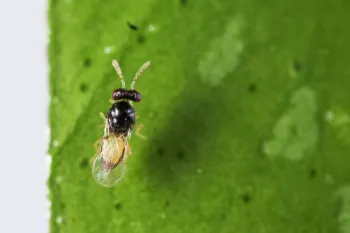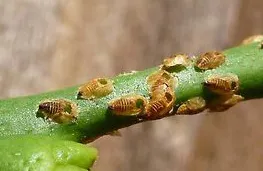
One of the most promising biological control agents is the parasitoid wasp, Tamarixia radiata. This tiny stingless wasp, which poses no threat to people, lays an egg underneath the ACP nymph, which then hatches, feeds on and kills the nymph. It is easy to find evidence of this parasitoid at work because it leaves behind what looks like a hollowed-out ACP nymphal shell, known as a “mummy”. The mummy has an exit hole where the adult parasite chewed its way out. Tamarixia and general predators have reduced psyllid populations in southern California, but their impact alone may not not be enough to prevent disease spread.

Since late 2011, this beneficial wasp has been mass-reared in an insectary and released into urban and suburban areas of Southern California (see video) by the California Department of Food & Agriculture. Another species of parasitoid, Diaphorencyrtus aligarhensis, was also mass-reared and released for a short time. As of Fall 2021 more than 23 million wasps have been released at residential sites throughout southern California and some areas of central California.
The Map of Psyllids, HLB and Parasites can be used to show the areas where Tamarixia and Diaphorencyrtis wasps have been released (data provided by CDFA). To show the release locations, click on the "Layers" icon, then toggle on/off the Tamarixia or Diaphorencytus layers.
ANT Control to protect natural enemies is critical!
Ants climb citrus and feed on the honeydew that is stored in the white tubules that the ACP nymphs produce. While doing that, they aggressively protect psyllids from natural enemies. To protect Tamarixia and other natural enemies, and to help the do a better job of controlling ACP, protect them by managing ants in your yard. See the UCIPM pest note on ants for information about how to identify and manage ants.

